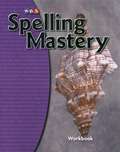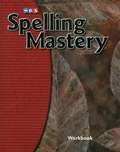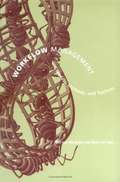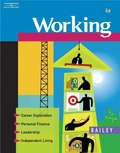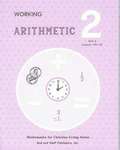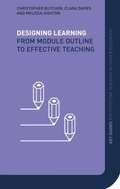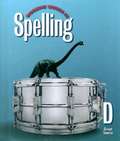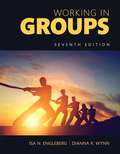- Table View
- List View
Workbook, Level D (SRA Connecting Math Concepts)
by Jerry Silbert Siegfried Engelmann Owen EngelmannNIMAC-sourced textbook
Workbook, Level F [Grade 6]
by Siegfried Engelmann Robert Dixon Donald SteelySpelling Mastery, Student Workbooks, Level F Replacing the old assign-and-test spelling book, Spelling Mastery is an effective, research-based program presents spelling strategies, patterns, and reliable rules. Benefits: Spelling Mastery interweaves three spelling strategies according to students' skill development. The phonemic approach helps beginning spellers learn and apply relationships between spoken sound and written letters to spelling. The morphemic approach shows advanced spellers how to spell prefixes, bases, suffixes and how to combine them to spell multisyllabic words. The intensive whole-word approach teaches students at all levels common words that cannot be taught with phonemic or morphemic strategies. Reliable spelling rules help students move beyond memorization to understand how words are spelled.
Workflow Management: Models, Methods, and Systems
by Wil Van der Aalst Kees Van HeeThis book offers a comprehensive introduction to workflow management, the management of business processes with information technology. By defining, analyzing, and redesigning an organization's resources and operations, workflow management systems ensure that the right information reaches the right person or computer application at the right time. The book provides a basic overview of workflow terminology and organization, as well as detailed coverage of workflow modeling with Petri nets. Because Petri nets make definitions easier to understand for nonexperts, they facilitate communication between designers and users. The book includes a chapter of case studies, review exercises, and a glossary.
Working
by Larry J. BaileyThis revision of Working: Career Success for the 21st Century introduces high school seniors and community college students to career planning, working, money management, and essential skills for independent living. Learning features include chapter summaries, activities, and vocabulary exercises, plus boxes on high growth occupations, math connections, and career decision making. This edition spans the entire life/work cycle, and material reflecting the Department of Education's 16 career clusters has been added. Bailey is affiliated with the Department of Workforce Education and Development. Annotation ©2006 Book News, Inc. , Portland, OR (booknews. com)
Working Dogs
by Jessica QuiltyThe fun and excitement of English and Language Arts learning continues in Grade 2 of Reading Street. This comprehensive and dynamic curriculum for homeschooling is geared toward young children who have some foundational English and Language Arts knowledge and are ready to strengthen their skills. Comprised of engaging activities, challenging content and weekly quizzes, Reading Street: Grade 2 is the next step in your child's path toward becoming a lifelong learner and reader. As with all Reading Street products, the Grade 2 system is formatted to help students meet certain age-appropriate goals. After completing this English and Language Arts homeschool program, your child should be able to: Read and comprehend two-syllable words. Identify common prefixes (such as pre-, un-, or re-) and suffixes (such as -able, -ad and -er). Correct mistakes made when reading out loud. Read books with two or more chapters. Understand the structure of stores (i. e. beginning, middle and end). Start selecting reading materials based on his/her own interests. Identify the "who," "what," "when," "where," "why" and "how" of the text. While the goals of second Grade English and Language Arts are numerous, Reading Street will help you craft engrossing lessons. Your child will garner important English and Language Arts skills while completing a workbook, reading stories and poems, and taking assessments. Planning these lessons will be easier than ever, as all Reading Street systems are broken down into weekly Big Ideas. All the work your child does on a given week is formulated around that single concept for an organized and challenging curriculum. With six easy-to-follow units, Reading Street: Grade 2 is the perfect tool for homeschooling parents. Your child will enjoy the reading selections and activities, and you'll love to see your student growing into a knowledgeable individual. We're confident that this product is the right one for you. For more information on the specific materials found in Grade 2 of Reading Street, check out the Features and Benefits page.
Working Hand in Hand, Pathfinder Edition (National Geographic Explorer Collection)
by Diane G. SilverNIMAC-sourced textbook
Working Hand in Hand, Pioneer Edition (National Geographic Explorer Collection)
by Diane G. SilverNIMAC-sourced textbook
Working Hard to Help (Reach Into Phonics Ser.)
by Deborah J. Short Mark Gaines Olivia LeeNIMAC-sourced textbook
Working One-to-one With Students: Supervising, Coaching, Mentoring, And Personal Tutoring
by Jane Clarke Kate Exley Gina Wisker Maria Antoniou Pauline RidleyWorking One-to-One with Studentsis written for Higher Education academics, adjuncts, teaching assistants and research students who are looking for guidance inside and outside the classroom. This book is a jargon-free, practical guide to improving one-to-one teaching, covering a wide range of teaching contexts, including mentoring students and staff, supervising dissertations and how to approach informal meetings outside of lectures. Written in an engaging, accessible style and grounded in experience, this book offers a combination of practical advice backed by relevant learning theory. Featuring a wealth of case studies and useful resources, the book covers areas including: Supporting students Encouraging independent learning Mentoring coaching and personal tutoring Developing peer groups and buddying programs Dealing with diversity, difficult students and ethical dilemmas supervising the undergraduate dissertation Supervising postgraduates in the arts, social sciences and sciences. This book is a short, snappy, practical guide that covers this key element of a lecturer's work. In the spirit of the series (KEY GUIDES FOR EFFECTIVE TEACHING in HIGHER EDUCATION) this book covers relevant theory that effectively informs practice.
Working Papers Multicolumn Journal Century 21 South Western Accounting
by Claudia Bienias Gilbertson Mark W. Lehman Kenton E. RossWe've eliminated the overlap between problems, making it easier for students to complete and teachers to grade. These Working Papers are to be used in the study of chapters 1-16 of C21 Accounting, Multicolumn Journal Approach. Forms are provided for: Work Together exercises, On Your Own exercises, Application Problems, Mastery Problems, Challenge Problems, Reinforcement Activities 1 and 2. Printed on each page is the number of the problem in the textbook for which the form is to be used. Also shown is a specific instruction number for which the form is to be used. You may not have to use every form that is provided.
Working Together
by Tammy Jones Margie Burton Cathy FrenchThis book is about the importance of helping out at home.
Working With Young Children
by Judy HerrWorking with Young Children brings to life the fascinating career opportunities in the early childhood profession. The text presents an in-depth, comprehensive study of all aspects of the early childhood field to help prepare your students for workplace success. <p><p>Topics include: <p>• child development principles as applied to the early childhood program setting <p>• the learning needs of young children including those who have special needs <p>• appropriate child guidance and group management techniques <p>• developmentally appropriate practices in curriculum development <p><p>Additionally, students will acquire skills for preparing an engaging learning environment that encourages children to independently experiment, explore, and manipulate the classroom materials. The text also provides information about licensing rules and regulations, various career paths, and safety and health considerations. Studying this information helps prepare students for workplace success. <p><p> Working with Young Children offers the foundational knowledge and skills necessary to work toward the Child Development Associate™ Credential and other career-related credentials, By acquiring such credentials, students can jump-start their careers in the early childhood profession.
Working Words In Spelling: Grade 4
by G. Willard Woodruff Great Source Education Group Staff George N. Moore Robert G. Forest Richard A. Talbot Ann R. TalbotWorking Words in Spelling helps all students achieve spelling success--- Lessons begin with a pretest and proofreading activity to help students identify problem areas. - Students learn more than 4,000 high-frequency base words plus 13,000 related forms--99% of the most commonly used words in both student and adult writing. - Challenge words for every lesson motivate higher-ability students. - Writing activities help transfer accurate spelling to daily writing. - Yellow Pages are a handy spelling reference to help students improve their spelling.
Working Words in Spelling (E)
by G. Willard Woodruff George N. Moore Robert G. Forest Richard A. Talbot Ann R. TalbotBecome a SHARP speller by using the following:<P> * See the word.<P> * Hear the word.<P> * Adopt the word.<P> * Record the word. <P> * Proofread the word. <P>
Working at Night (Fountas & Pinnell Classroom, Guided Reading Grade 2)
by Sondra AlanNIMAC-sourced textbook
Working in Groups: Communication Principles and Strategies
by Isa N. Engleberg Dianna R. WynnThis book provides students with practical strategies, built on theory and research, for communicating and working successfully in groups. Utilizing the concept of balance as a unifying metaphor, authors Isa Engleberg and Dianna Wynn help students acquire the tools to apply group communication theories, methods, and skills effectively–helping them become more valuable and ethical group members. The Seventh Edition offers coverage of fresh topics as well as a new closing chapter on group presentations that better helps students master this key skill.
Working in the Clouds: A City Window Washer (Fountas & Pinnell Classroom, Guided Reading Grade 4)
by Brianna Roberts Kanako YuzuruSwinging Superheroes? Look up at a skyscraper and you might see a few brave people swinging and crawling on the outside of the building. They may look like superheroes or daredevils, but they're not doing a stunt. It's a crew of high-rise window washers doing a difficult and dangerous job. NIMAC-sourced textbook
Working it Out: The Blue Edition
by Company D. C. HeathDoing the right thing helps resolve any conflict whether personal or global. When you try to do the right thing, what happens?
Working with Babies and Children (Second Edition): From Birth to Three
by Cathy Nutbrown Jools Page Ann Clare'The first edition of this book set a milestone in writing about under threes. This second edition builds on that great achievement: its thinking about loving interactions in nurseries marks it out for its bravery and profound importance for a new generation of practice'-Peter Elfer, University of Roehampton 'The authors skilfully interlace theory and practice, foregrounding an ethic of respect and prompting critical reflection and dialogue' -Dr Sacha Powell, Reader in Early Childhood, Canterbury Christ Church University 'This clear, authoritative and scholarly book is informed by the authors' huge respect and affection for young children and those who work with them. A must-read'-Helen Moylett, Early Learning Consultancy This book is essential for all who work with children under three. Due to its combination of theory and practice, clear writing and pedagogical material. The second edition contains extensive updates on policy, new case studies, and activities from current settings. This revised edition emphasises: - child development and learning - attachment/key person relationships - planning the environment for babies - understanding every child - working with parents This book will be useful to those on initial training courses, such as Foundation degrees, NVQ, BA Education and Early Childhood Studies, and for managers and practitioners undertaking CPD. Jools Page teaches on the MA in Early Childhood Education at the University of Sheffield. Ann Clare is an Associate Tutor at the University of Sheffield. Cathy Nutbrown is Head of the School of Education at the University of Sheffield.
Working with Electricity and Magnetism
by Pam Hirschfeld Kathy FurgangFind out about electricity and magnetism by investigating the concepts of static electricity, current, electricity, magnetism, and electromagnetism.
Working with Students with Emotional and Behavior Disorders: Characteristics and Teaching Strategies
by Terry L. ShepherdThe book is about children who have been identified as having emotional and behavior disorders, those who have not been identified, those who are depressed and suicidal, and those who display aggressive behavior in the classroom. This book is a practical guide combining theory, best practices, strategies, and interventions and is useful for beginning teachers, seasoned teachers, alternatively certified teachers, counselors, parents, and administrators.


